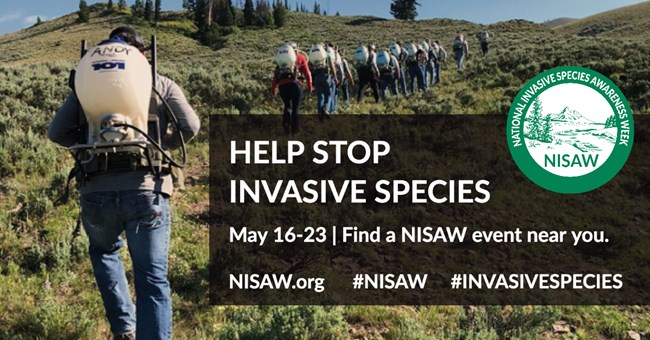Part of a series of articles titled The Midden - Great Basin National Park: Vol. 20, No. 1, Summer 2020.
Article
National Invasive Species Awareness Week 2020
This article was originally published in The Midden – Great Basin National Park: Vol. 20, No. 1, Summer 2020.

help find invasive species anytime!
National Invasive Species Awareness Week, or NISAW, begins on May 16, 2020. NISAW supports events across the nation to raise awareness and identify solutions to invasive species issues at local, state, tribal, national, and international levels. The goal of this public awareness campaign is to support education, legislation, and practical efforts to stop the spread of invasive plant and animal species on the nation’s lands and waterways to preserve natural ecosystems for the benefit of everyone.
Invasive species have the potential to negatively impact both natural and cultivated landscapes we enjoy and rely on. During this time of social distancing, people are spending more time outside and getting reacquainted with backyards, local open spaces, empty lots, and alleyways. People spending more time outdoors in their local area provides a great opportunity to locate and report invasive species infestations.

NPS Photo by Julie Long
EDDMapS stands for Early Detection and Distribution Mapping System. This web-based platform allows citizen scientists, land managers, state agencies, and pest management professionals to report invasive species locations and explore invasive species information and distribution maps. EDDMapS’ goal is to maximize the effectiveness and accessibility of the immense numbers of invasive species and pest observations recorded each year. As of April 2020, EDDMapS has over 4.8 million records. This data will become the foundation for a better understanding of invasive species and pest distribution around the world.
How can you report? Check out the EDDMapS website and download the app to your smartphone.
Here are some other ways that NISAW.org encourages you to help: Learn about invasive species, especially those found in your region. Your county extension office (here's White Pine County's) and State Department of Agriculture website are both trusted resources. Clean hiking boots, waders, boats and trailers, off-road vehicles, and other gear to stop invasive species from hitching a ride to a new location.

NPS Photo by Julie Long
There are a variety of other online resources to learn more, increase your impact as a citizen scientist, and help protect local landscapes – Don’t Move Firewood Website, Habitattitude Website, Wild Spotter Website and iNaturalist Website. Invasive species data collected with Wild Spotter and iNaturalist are included in the EDDMapS database.
Last updated: February 8, 2024
